Study on the Ecological Interaction Mechanism of Continuous Cropping Soil Driven by Different Modifiers
Abstract
:1. Introduction
2. Materials and Methods
2.1. Study Area Overview
2.2. Experimental Setup
2.3. Tomato Fruit Yield and Quality Determination
2.4. Soil Sample Collection and Pretreatment
2.5. Determination of Soil Physical and Chemical Indexes and Soil Enzyme Activity
2.6. Soil DNA Extraction and Microbial Community Analysis
2.7. Statistical Analysis
3. Results and Analysis
3.1. Effects of Different Amendments on Tomato Yield and Quality
3.2. Effects of Different Amendments on Physical and Chemical Properties of Tomato Continuous Cropping Rhizosphere Soil
3.3. Effects of Different Amendments on Enzyme Activities in Rhizosphere Soil of Tomato Continuous Cropping
3.4. Microbial Community Diversity in Rhizosphere Soil
3.5. Composition of Microbial Community Structure in Rhizosphere Soil
3.6. Functional Characteristics of Rhizosphere Soil Microbial Community
3.7. Correlation Between Rhizosphere Microbial Community Structure and Soil Physical and Chemical Properties and Soil Enzyme Activities
4. Discussion
5. Conclusions
Supplementary Materials
Author Contributions
Funding
Data Availability Statement
Conflicts of Interest
References
- Wu, Z.; Jiang, J.; Dong, W.; Cui, S. The Spatiotemporal Characteristics and Driving Factors of Soil Degradation in the Black Soil Region of Northeast China. Agronomy 2024, 14, 2870. [Google Scholar] [CrossRef]
- Han, S.; Ji, X.; Huang, L.; Liu, G.; Ye, J.; Wang, A. Effects of aftercrop tomato and maize on the soil microenvironment and microbial diversity in a long-term cotton continuous cropping field. Front. Microbiol. 2024, 15, 1410219. [Google Scholar] [CrossRef]
- Zhao, X.; Xie, P.; Zhang, X.; Ou, Z.; Ma, H.; Suo, C.; Ma, J.; Wan, P. Characteristics of different aged plantations of Ormosia hosiei with regards to soil microbial biomass and enzymatic activities. J. For. Res. 2024, 35, 119. [Google Scholar] [CrossRef]
- Kumar, A.; Das, A.; Singh, D.; Das, M.K.; Srivastava, G.P.; Singh, J.P.; Tilgam, J.; Thapa, S.; Das, S.; Chakdar, H. Soil health restoration in degraded lands: A microbiological perspective. Land Degrad. Dev. 2023, 34, 5155–5170. [Google Scholar] [CrossRef]
- Bai, Y.; Wang, G.; Cheng, Y.; Shi, P.; Yang, C.; Yang, H.; Xu, Z. Soil acidification in continuously cropped tobacco alters bacterial community structure and diversity via the accumulation of phenolic acids. Sci. Rep. 2019, 9, 12499. [Google Scholar] [CrossRef]
- Song, X.; Huang, L.; Li, Y.; Zhao, C.; Tao, B.; Zhang, W. Characteristics of soil fungal communities in soybean rotations. Front. Plant Sci. 2022, 13, 926731. [Google Scholar] [CrossRef] [PubMed]
- Stefan, L.; Hartmann, M.; Engbersen, N.; Six, J.; Schöb, C. Positive effects of crop diversity on productivity driven by changes in soil microbial composition. Front. Microbiol. 2021, 12, 660749. [Google Scholar] [CrossRef]
- Sanguineti, D.; Zampieri, G.; Treu, L.; Campanaro, S. Metapresence: A tool for accurate species detection in metagenomics based on the genome-wide distribution of mapping reads. mSystems 2024, 9, e00213-24. [Google Scholar] [CrossRef]
- Prosser, J.I. Dispersing misconceptions and identifying opportunities for the use of ‘omics’ in soil microbial ecology. Nat. Rev. Microbiol. 2015, 13, 439–446. [Google Scholar] [CrossRef]
- Liao, H.; Ji, Y.; Sun, Y. High-resolution strain-level microbiome composition analysis from short reads. Microbiome 2023, 11, 183. [Google Scholar] [CrossRef]
- Sun, S.; Badgley, B.D. Changes in microbial functional genes within the soil metagenome during forest ecosystem restoration. Soil Biol. Biochem. 2019, 135, 163–172. [Google Scholar] [CrossRef]
- Heijden, M.G.A.V.D.; Bardgett, R.D.; Van Straalen, N.M.V. The unseen majority: Soil microbes as drivers of plant diversity and productivity in terrestrial ecosystems. Ecol. Lett. 2008, 11, 296–310. [Google Scholar] [CrossRef] [PubMed]
- Jiang, C.; Zu, C.; Riaz, M.; Li, C.; Zhu, Q.; Xia, H.; Dong, Q.; Shen, J. Influences of tobacco straw return with lime on microbial community structure of tobacco-planting soil and tobacco leaf quality. Environ. Sci. Pollut. Res. 2024, 21, 30959–30971. [Google Scholar] [CrossRef]
- Hera, O.; Sturzeanu, M.; Vîjan, L.E.; Tudor, V.; Teodorescu, R. Biochemical Evaluation of Some Fruit Characteristics of Blueberry Progenies Obtained from ‘Simultan × Duke’. ACS Omega 2023, 8, 18603–18616. [Google Scholar] [CrossRef]
- Jiang, Y.; Wang, J.; Liu, L.; Chen, L.; Yin, X.; Tan, W.; Yan, L.; Shen, T. Synergistic changes in bacterial community composition, function, and soil characteristics of tomato rhizosphere soil under long-term monoculture conditions. Rhizosphere 2024, 31, 100950. [Google Scholar] [CrossRef]
- Wei, X.; Xie, B.; Wan, C.; Song, R.; Zhong, W.; Xin, S.; Song, K. Enhancing soil health and plant growth through microbial fertilizers: Mechanisms, benefits, and sustainable agricultural practices. Agronomy 2024, 14, 609. [Google Scholar] [CrossRef]
- Balemi, T.; Negisho, K. Management of soil phosphorus and plant adaptation mechanisms to phosphorus stress for sustainable crop production: A review. J. Soil Sci. Plant Nutr. 2012, 12, 547–562. [Google Scholar] [CrossRef]
- Toan, N.S.; Nguyen, T.D.P.; Thu, T.T.N.; Lim, D.T.; Dong, P.D.; Gia, N.T.; Khoo, K.; Chew, K.; Show, P.L. Soil mineralization as effects of plant growth promoting bacteria isolated from microalgae in wastewater and rice straw application in a long-term paddy rice in Central Viet Nam. Environ. Technol. Innov. 2021, 24, 101982. [Google Scholar] [CrossRef]
- Mokemiabeka, N.S.; Niebi, A.L.N.J.; Kayath, C.A.; Boundzou, K.G.E.; Nguibi, E. Involvement of Bacillus species in the understanding of the softening process of safou pulp (Dacryodes edulis HJ Lam). Int. J. Sci. Res. 2021, 10, 355–359. [Google Scholar] [CrossRef]
- Wang, Y.; Xu, X.; Liu, T.; Wang, H.; Zhu, S. Analysis of bacterial and fungal communities in continuous-cropping ramie (Boehmeria nivea L. gaud) fields in different areas in china. Sci. Rep. 2020, 10, 3264. [Google Scholar] [CrossRef]
- Dai, Z.; Su, W.; Chen, H.; Barberán, A.; Zhao, H.; Yu, M.; Yu, L.; Brookes, C.P.; Schadt, W.C.; Chang, X.S.; et al. Long-term nitrogen fertilization decreases bacterial diversity and favors the growth of Actinobacteria and Proteobacteria in agro-ecosystems across the globe. Glob. Change Biol. 2018, 24, 3452–3461. [Google Scholar] [CrossRef]
- Roley, S.S. Diazotrophic nitrogen fixation in the rhizosphere and endosphere. In Rhizosphere Biology: Interactions Between Microbes and Plants; Springer: Singapore, 2021; pp. 93–108. [Google Scholar] [CrossRef]
- Hou, Y.; Jia, R.; Zhou, L.; Zhang, L.; Li, B.; Zhu, J. Different Fish Farming Patterns in Paddy Fields Substantially Impact the Bacterial Community Composition, Stability, and Assembly Processes in Paddy Water. Agriculture 2024, 14, 2306. [Google Scholar] [CrossRef]
- Tian, T.; Chen, Z.; Tian, Y.; Gao, L. Microbial diversity in solar greenhouse soils in Round-Bohai Bay-Region, China: The influence of cultivation year and environmental condition. Environ. Sci. Pollut. Res. 2017, 24, 23236–23249. [Google Scholar] [CrossRef] [PubMed]
- Rissanen, A.J.; Ojala, A.; Fred, T.; Toivonen, J.; Tiirola, M. Methylophilaceae and Hyphomicrobium as target taxonomic groups in monitoring the function of methanol-fed denitrification biofilters in municipal wastewater treatment plants. J. Ind. Microbiol. Biotechnol. 2017, 44, 35–47. [Google Scholar] [CrossRef] [PubMed]
- Wang, Z.; Zhang, W.; Beebout, S.S.; Zhang, H.; Liu, L.; Yang, J.; Zhang, J. Grain yield, water and nitrogen use efficiencies of rice as influenced by irrigation regimes and their interaction with nitrogen rates. Field Crops Res. 2016, 193, 54–69. [Google Scholar] [CrossRef]
- Jansson, J.K.; Baker, E.S. A multi-omic future for microbiome studies. Nat. Microbiol. 2016, 1, 16049. [Google Scholar] [CrossRef]
- Li, H.; Li, W.; Ge, F.; Li, J.; Tu, S.; Yang, H.; Ren, Y.; Gong, X.; Yao, C. Unveiling the regulatory mechanism of poly-γ-glutamic acid on soil characteristics under drought stress through integrated metagenomics and metabolomics analysis. Front. Microbiol. 2024, 15, 1387223. [Google Scholar] [CrossRef]
- Logue, J.B.; Findlay, S.E.G.; Comte, J. Editorial: Microbial responses to environmental changes. Front. Microbiol. 2015, 6, 204–221. [Google Scholar] [CrossRef]
- Wang, M.; Zhao, S.; Wang, L.; Chen, S.; Li, S.; Lei, X.; Sun, X.; Qin, L. Salt stress-induced changes in microbial community structures and metabolic processes result in increased soil cadmium availability. Sci. Total Environ. 2021, 782, 147125. [Google Scholar] [CrossRef]
- Li, C.; Yu, J.; Li, Z.; Yang, J.; Chen, S.; Yang, Y.; Yang, C.; Hu, Y. Exogenous application of sodium hydrosulfide suppresses bacterial wilt and regulates the soil microecology. Preprints 2021. [Google Scholar] [CrossRef]
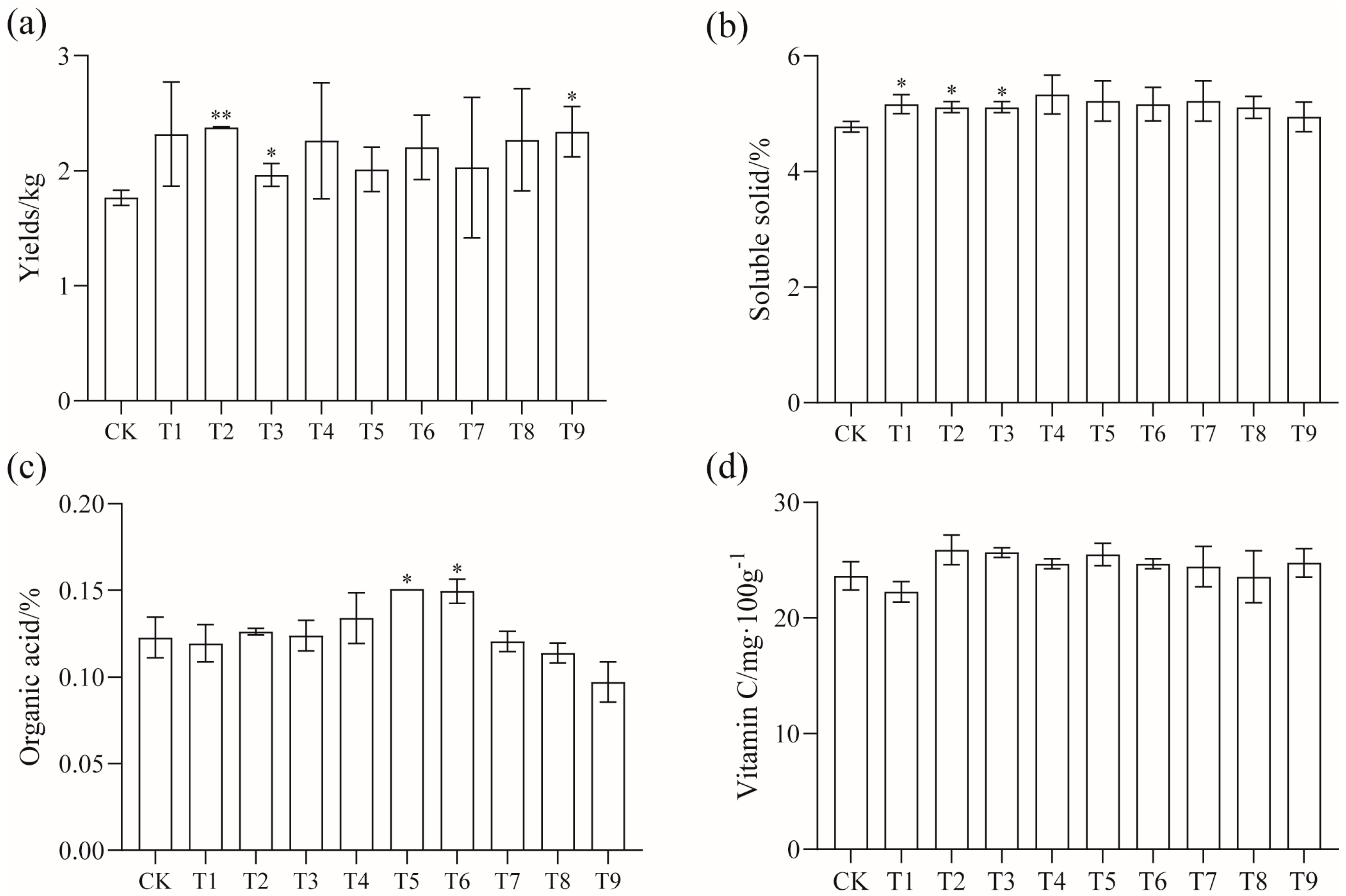
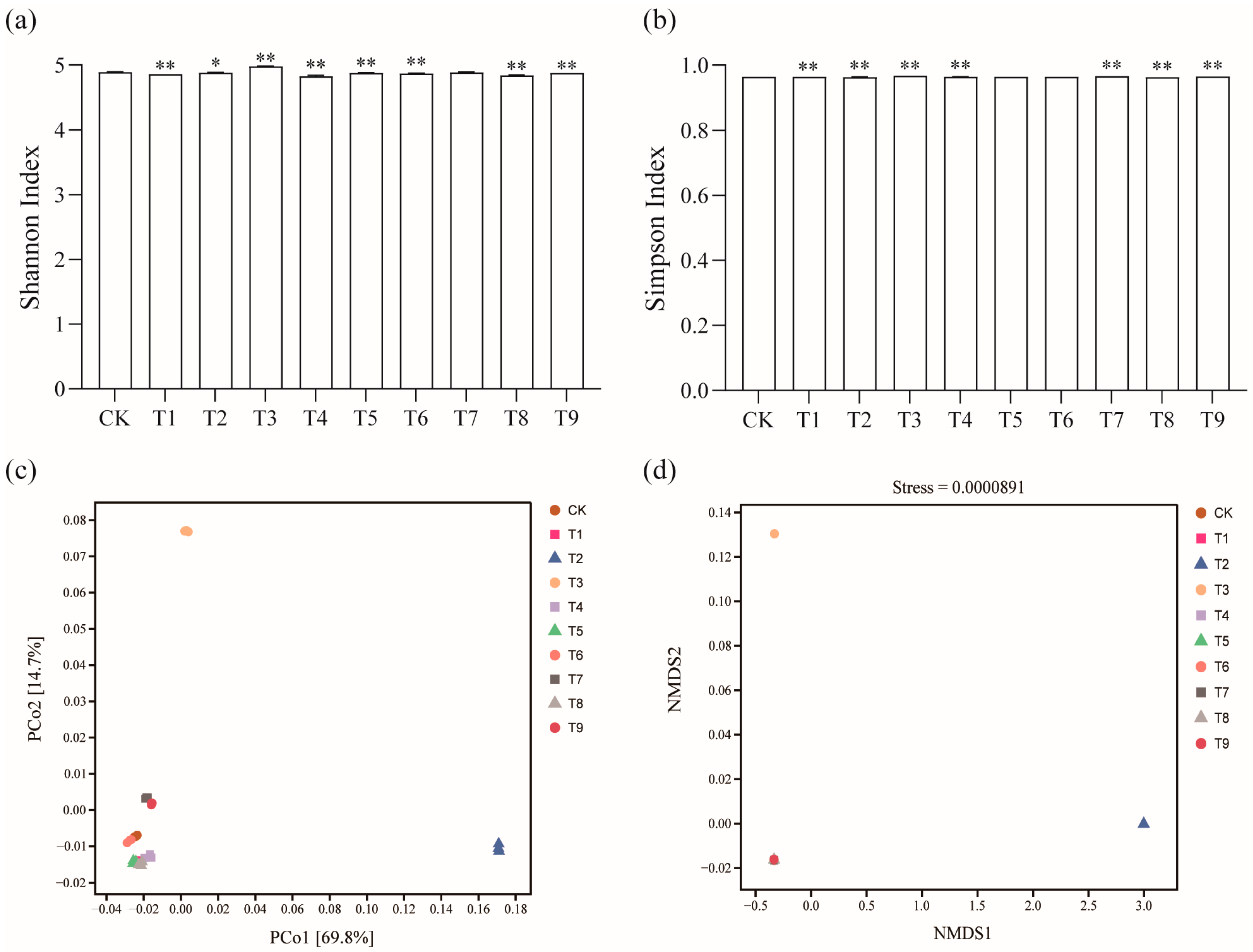

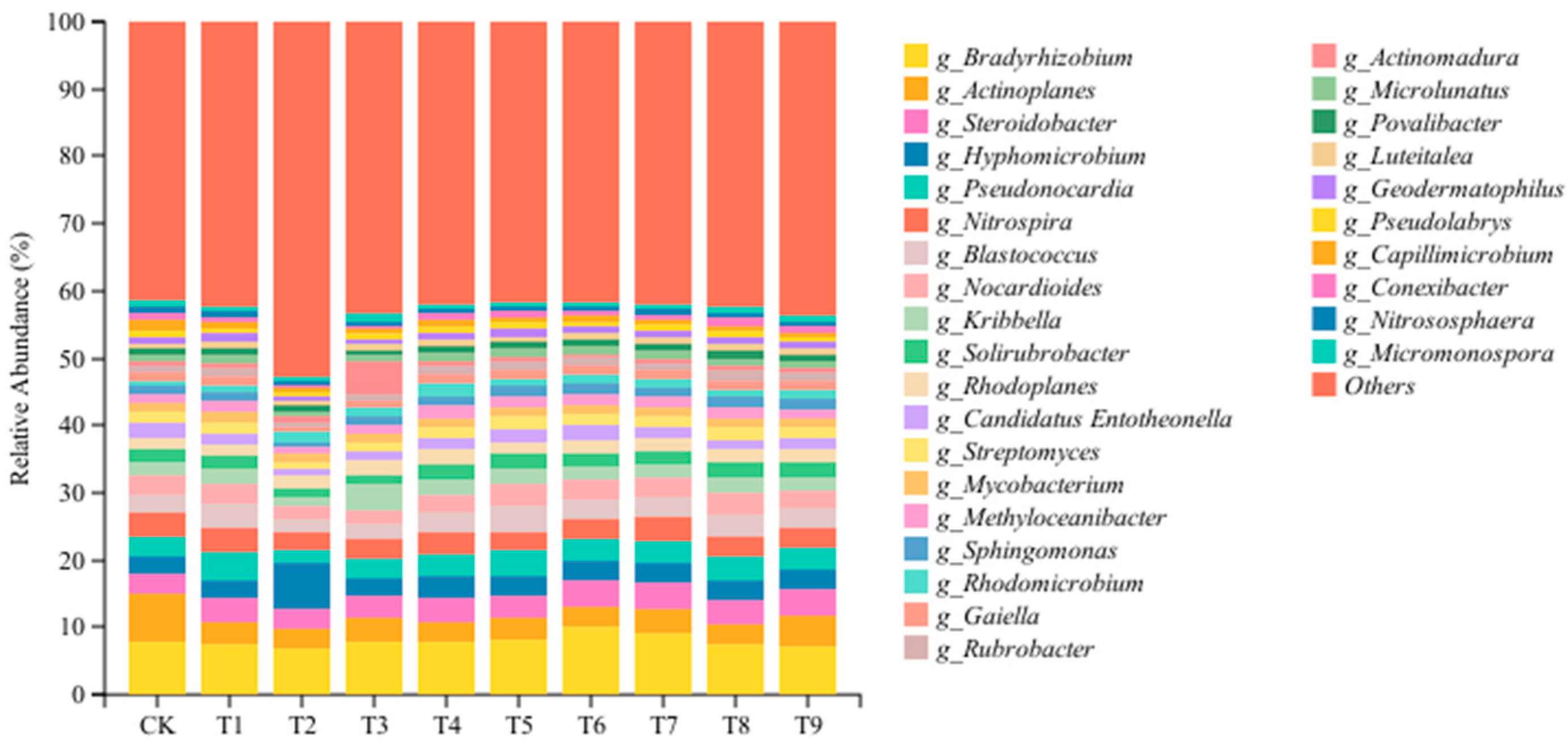
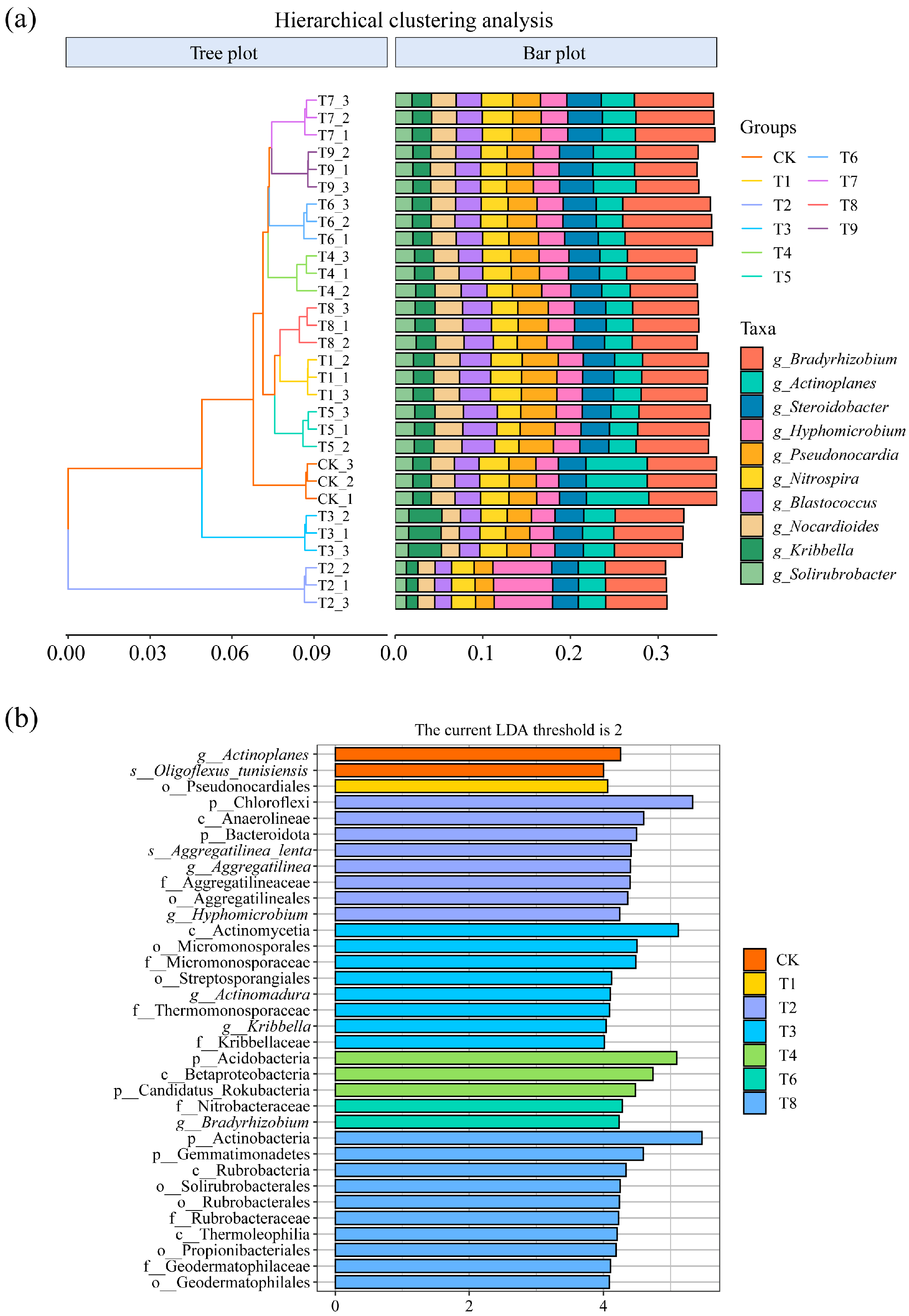
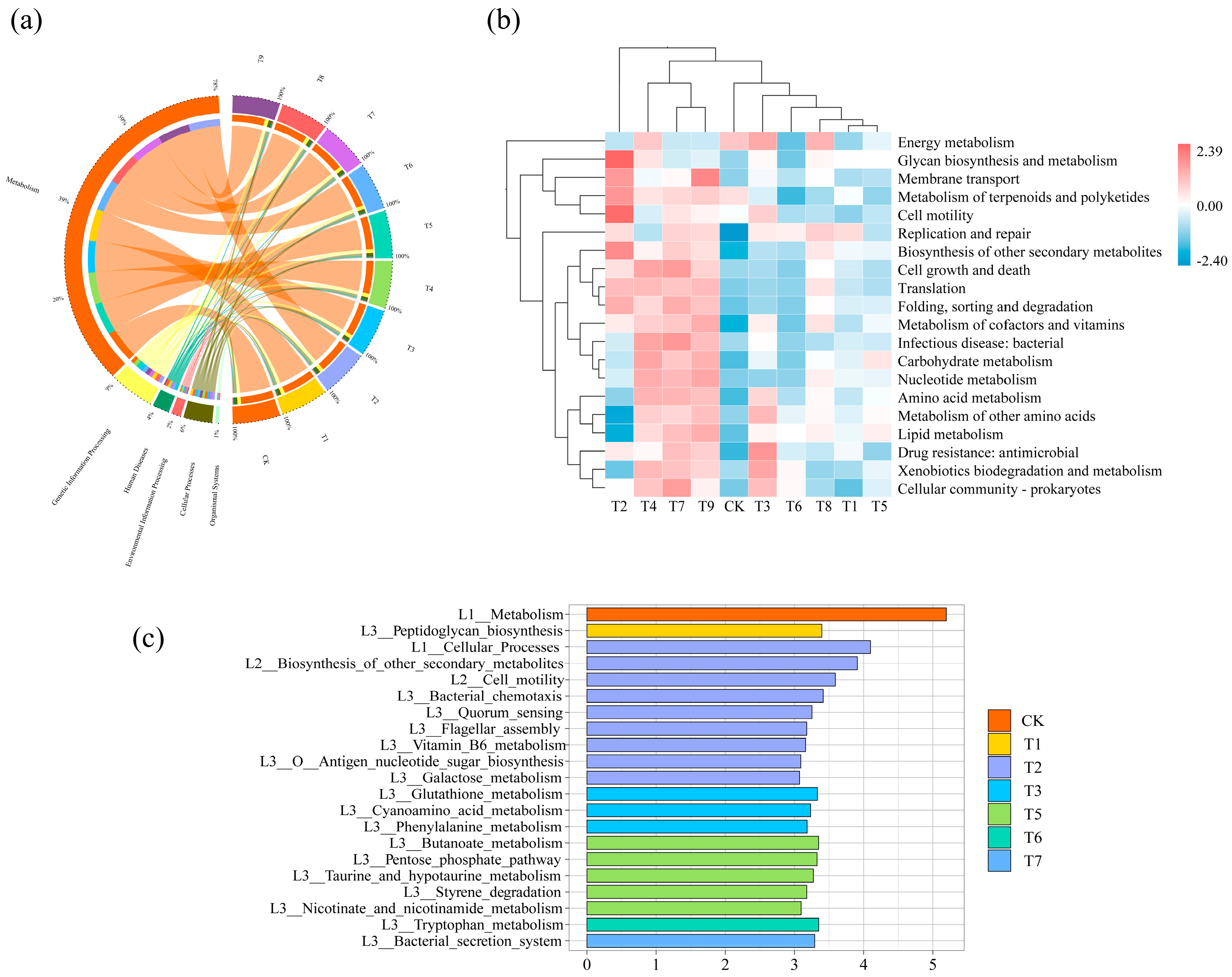

| Treatment | Material Combination and Dosage per mu | Mode |
|---|---|---|
| CK | Soil conventional fertilization treatment for 14 years of continuous cropping | Ditching |
| T1 | Bacillus subtilis 2 kg/mu + Trichoderma harzianum 2 kg/mu | Ditching |
| T2 | Farm manure 3000 kg/mu + Bacillus subtilis 2 kg/mu + Trichoderma harzianum 2 kg/mu | Ditching |
| T3 | Plant-derived straw rotten soil 3000 kg/mu + Bacillus subtilis 2 kg/mu + Trichoderma harzianum 2 kg/mu | Ditching |
| T4 | Zhongnong 6 Kang 1 kg/mu. | Ditching |
| T5 | Zhongnong Lvkang anti-continuous cropping micro-ecological agent 4 kg/mu | Ditching |
| T6 | Blue Sea Peninsula soil conditioner 150 kg/mu | Ditching |
| T7 | 300 times diluted solution of Zhongshu Genbao 120 | 500 mL root irrigation per plant |
| T8 | Zhanteng 5 kg/mu (base fertilizer) | Ditching |
| T9 | Mujianda (organic matter + Bacillus subtilis + Purple Spore + Trichoderma harzianum base fertilizer) 5 kg/mu | Ditching |
| Treatment | 20 d | 40 d | 60 d | |||
|---|---|---|---|---|---|---|
| Height | Stem Diameter | Height | Stem Diameter | Height | Stem Diameter | |
| CK | 29.21 ± 0.89 | 7.62 ± 0.34 | 86.4 ± 3.13 | 10.22 ± 0.11 | 124.19 ± 9.13 | 10.95 ± 0.88 |
| T1 | 29.93 ± 2.32 | 7.33 ± 1.23 | 91.38 ± 5.82 | 10.65 ± 0.59 | 135.07 ± 10.24 | 10.86 ± 0.71 |
| T2 | 31.81 ± 1.75 | 8.35 ± 0.38 | 97.92 ± 1.23 ** | 10.66 ± 0.02 ** | 147.09 ± 5.96 * | 10.74 ± 0.3 |
| T3 | 32.28 ± 0.41 ** | 8.6 ± 0.11 ** | 94.47 ± 2.3 * | 10.31 ± 0.22 | 137.57 ± 3.35 | 11.35 ± 0.52 |
| T4 | 30.29 ± 2.27 | 7.98 ± 1.07 | 96.61 ± 4.28 * | 10.06 ± 0.45 | 142.98 ± 9.22 | 10.74 ± 0.14 |
| T5 | 29.44 ± 4.01 | 7.48 ± 0.92 | 97.82 ± 6.67 | 10.66 ± 0.75 | 147.86 ± 8.49 * | 11.44 ± 0.52 |
| T6 | 31.11 ± 2.68 | 8.1 ± 0.33 | 95.23 ± 2.18 * | 10.33 ± 0.32 | 142.03 ± 9.55 | 10.76 ± 0.7 |
| T7 | 34.38 ± 3.93 | 8.79 ± 0.36 * | 100.02 ± 2.75 ** | 10.28 ± 0.51 | 146.18 ± 8.77 * | 11.34 ± 0.42 |
| T8 | 33.1 ± 1.23 * | 8.57 ± 0.28 * | 98.29 ± 2.64 ** | 10.85 ± 0.36 * | 133.65 ± 6.63 | 11.02 ± 0.41 |
| T9 | 32.93 ± 2.63 | 8.77 ± 0.49 * | 96.56 ± 2.84 * | 11.02 ± 0.39 * | 140.46 ± 0.64 | 11.2 ± 0.22 |
| Treatment | pH | EC (µs/cm) | HN (mg/kg) | AP (mg/kg) | AK (mg/kg) | OM (g/kg) | TN% |
|---|---|---|---|---|---|---|---|
| CK | 7.67 ± 0.05 | 76 ± 4.26 | 125.97 ± 6.6 | 136.23 ± 10.52 | 197 ± 6.08 | 36.2 ± 0.87 | 0.17 |
| T1 | 7.88 ± 0.1 * | 86.56 ± 16.19 | 123.87 ± 10.59 | 122.67 ± 12.83 | 205.33 ± 13.32 | 35.8 ± 1.71 | 0.18 ± 0.01 |
| T2 | 7.82 ± 0.08 * | 103.56 ± 16.55 * | 178.67 ± 24.5 * | 207.67 ± 29.46 * | 285.67 ± 20.4 ** | 45.07 ± 3.93 * | 0.24 ± 0.02 ** |
| T3 | 7.81 ± 0.17 | 75 ± 5.36 | 170.67 ± 23.98 * | 156.03 ± 20.44 | 265.33 ± 33.17 * | 53.57 ± 2.01 ** | 0.26 ** |
| T4 | 7.91 ± 0.13 * | 94.44 ± 8.34 * | 128.93 ± 5.93 | 158.1 ± 18.86 | 158.33 ± 119.44 | 35.8 ± 1.15 | 0.19 ** |
| T5 | 7.72 ± 0.19 | 73.11 ± 6.18 | 127.53 ± 8.78 | 169.1 ± 25.03 | 237.33 ± 17.9 * | 35.6 ± 1.47 | 0.18 * |
| T6 | 7.7 ± 0.18 | 113.55 ± 11.16 ** | 124.33 ± 8.96 | 159.83 ± 22.59 | 226.67 ± 17.9 | 34.13 ± 3.79 | 0.18 ± 0.01 |
| T7 | 7.66 ± 0.1 | 109.78 ± 63.01 | 128.77 ± 9.67 | 176 ± 27.56 | 220.67 ± 10.97 * | 34.07 ± 1.65 | 0.19 ± 0.01 |
| T8 | 7.76 ± 0.17 | 97.89 ± 18.4 | 117.23 ± 0.57 | 160.23 ± 8.58 | 209.33 ± 9.07 | 34.2 ± 1.45 | 0.18 |
| T9 | 7.8 ± 0.13 | 71 ± 11.29 | 125.3 ± 8.5 | 152.27 ± 22.17 | 221.33 ± 8.96 * | 32.47 ± 3.37 | 0.18 ± 0.02 |
| Treatment | URE (U/g) | ALP (U/g) | CAT (U/g) | SUC (U/g) | CEL (U/g) | AST (U/g) |
|---|---|---|---|---|---|---|
| CK | 710.6 ± 66.32 | 14,225.62 ± 794.51 | 17.72 ± 1.02 | 19.67 ± 1.87 | 10.33 ± 2.05 | 14 ± 2.71 |
| T1 | 691.52 ± 82.9 | 15,326.7 ± 451.71 | 12.89 ± 2.41 * | 19.68 ± 5.68 | 9.56 ± 2.97 | 7.64 ± 1 * |
| T2 | 616.15 ± 74.35 | 27,292.37 ± 3387.21 ** | 12.55 ± 0.55 ** | 17.29 ± 2.86 | 17.69 ± 8.33 | 13.46 ± 0.16 |
| T3 | 581.6 ± 41.18 * | 16,767.73 ± 539.88 ** | 9.72 ± 0.98 ** | 16.78 ± 0.59 | 16.95 ± 3.01 | 13.69 ± 0.41 |
| T4 | 818.52 ± 107.17 | 14,007.43 ± 1226.64 | 15.39 ± 0.39 * | 18.6 ± 2.15 | 8.96 ± 0.54 | 14.51 ± 0.63 |
| T5 | 851.56 ± 31.17 * | 15,172.65 ± 1421.21 | 12.71 ± 3 | 21.38 ± 5.81 | 15.87 ± 2.44 | 13.84 ± 1.03 |
| T6 | 712.53 ± 60.83 | 14,813.38 ± 1640.25 | 17.47 ± 0.74 | 16.79 ± 2.35 | 13.43 ± 1.66 | 13.44 ± 0.48 |
| T7 | 761.32 ± 78.27 | 15,991.4 ± 396.77 * | 20.85 ± 2.26 | 30.94 ± 4.87 | 8.42 ± 0.38 * | 13.11 ± 1.84 |
| T8 | 650.34 ± 117.32 | 14,644.58 ± 781.71 | 15.99 ± 2.02 | 18.26 ± 1.41 | 7.65 ± 1 | 14.54 ± 0.32 |
| T9 | 617.62 ± 85.69 | 16,773.07 ± 1742.68 | 16.91 ± 2.38 | 17.68 ± 1.98 | 12.26 ± 2.49 | 13.12 ± 1.17 |
Disclaimer/Publisher’s Note: The statements, opinions and data contained in all publications are solely those of the individual author(s) and contributor(s) and not of MDPI and/or the editor(s). MDPI and/or the editor(s) disclaim responsibility for any injury to people or property resulting from any ideas, methods, instructions or products referred to in the content. |
© 2025 by the authors. Licensee MDPI, Basel, Switzerland. This article is an open access article distributed under the terms and conditions of the Creative Commons Attribution (CC BY) license (https://creativecommons.org/licenses/by/4.0/).
Share and Cite
Wang, J.; Wang, Y.; Tan, W.; Zhao, D.; Xu, C.; Wang, Z.; Liu, Y.; Liu, S.; Kang, J. Study on the Ecological Interaction Mechanism of Continuous Cropping Soil Driven by Different Modifiers. Horticulturae 2025, 11, 446. https://doi.org/10.3390/horticulturae11050446
Wang J, Wang Y, Tan W, Zhao D, Xu C, Wang Z, Liu Y, Liu S, Kang J. Study on the Ecological Interaction Mechanism of Continuous Cropping Soil Driven by Different Modifiers. Horticulturae. 2025; 11(5):446. https://doi.org/10.3390/horticulturae11050446
Chicago/Turabian StyleWang, Juan, Yuanyuan Wang, Wei Tan, Dan Zhao, Chunmei Xu, Zhiwei Wang, Yufeng Liu, Siyu Liu, and Jiayi Kang. 2025. "Study on the Ecological Interaction Mechanism of Continuous Cropping Soil Driven by Different Modifiers" Horticulturae 11, no. 5: 446. https://doi.org/10.3390/horticulturae11050446
APA StyleWang, J., Wang, Y., Tan, W., Zhao, D., Xu, C., Wang, Z., Liu, Y., Liu, S., & Kang, J. (2025). Study on the Ecological Interaction Mechanism of Continuous Cropping Soil Driven by Different Modifiers. Horticulturae, 11(5), 446. https://doi.org/10.3390/horticulturae11050446






